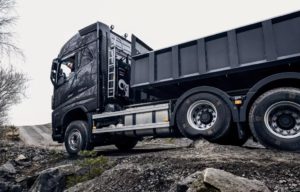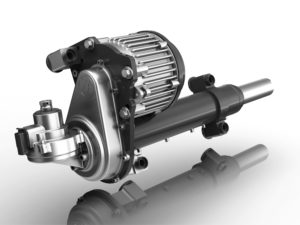As the road transport sector has moved towards electrification over the past few years, so manufacturers have also been developing new highly sophisticated electric steering systems.
This electric power steering (EPS) technology, designed to make commercial vehicles safer, more efficient and comfortable to drive, also holds the key to the success of highly automated driving.
According to ZF, its new electric steering system, suitable for a medium and heavy-duty trucks, coaches and city buses, provides the starting point for the next generation of Advanced Driver Assistance Systems (ADAS).
Replacing the hydraulic pump with an integrated e-motor makes the steering system independent of the vehicle’s drivetrain and removes the need for hydraulic fluid.
As a result, the technology is a seamless fit for electric vehicle architectures, and optimises the driving experience with its quiet and smooth electric operation.
Built to the highest automotive safety integrity level, available in 24V and 48V variants and supporting outputs up to 8,000 Nm, the modular EPS has a scalable design, meeting a range of packaging requirements and applicable to all powertrain concepts.
ZF’s EPS is currently ready for steer-by-wire and can potentially accommodate future automated driving functions up to Level Five.
As an active steering system, EPS can integrate with ADAS to support safety functions including, for example, continuous lane keeping.
Dr Christian Brenneke, Senior Vice President of Product Engineering in ZF’s Commercial Vehicle Solutions division, said the company can provide cost-efficient steering systems that are designed to lower the total cost of ownership.
“ZF is well-positioned as the preferred development partner for leading truck, coach and bus brands worldwide,” he said.
In an order worth more than £263 million, Knorr-Bremse is developing series production EPS systems for the entire commercial vehicle range of a so-far unnamed leading truck manufacturer.
In a first for the business, Knorr-Bremse will start supplying the EPS systems in 2025, steadily raising its content per vehicle over time.
The company is taking a modular approach to fit all commercial vehicle categories and therefore ease integration and installation.
Its steering system features various driver assistance functions such as speed-dependent power steering, active lane-keeping assistance and steering-wheel recentring, as well as exceptional – and individually adjustable – steering feedback.
According to Knorr-Bremse, it benefits from having core components that have been tested millions of times and meet all the correct safety and cybersecurity standards.
Knorr-Bremse has also designed an Advanced Hybrid Power Steering (AHPS) torque overlay steering system to fulfil ADAS and Highly Automated Driving (HAD) requirements.
Dr Jan Mrosik, CEO of Knorr-Bremse said: “Electric power steering is a key enabling technology in two senses.
“First, as the foundation for advanced driver assistance systems and automated driving, and second, because its power-on-demand principle also enables customers to significantly reduce fuel consumption and carbon emissions.
“By specializing in EPS, we are helping our customers achieve the new European CO2 targets that will come into force in 2025.”
Bosch has developed EPS variants that meet the requirements for light commercial vehicles.
With an electric motor the EPS controls and assists vehicle steering and provides an optimal steering feel.

Meanwhile, Volvo Dynamic Steering combines conventional hydraulic power steering with an electric motor that’s fitted to the steering gear.
By processing input from multiple sensors, the system works out where the truck is going as well as the intention of the driver.
The motor is controlled 2,000 times every second to correct unintentional steering movements and provide extra steering torque when needed.
At high speeds, Volvo Dynamic Steering is designed to keep a driver stable and on course, while providing steering force at lower speeds, no matter the load.
When reversing a fully loaded truck it returns the wheel to neutral automatically and a driver can reverse more than a 100 metres without drifting off course.
Building on this, Active Grip Control is a function that significantly improves stability and acceleration in slippery conditions.
If the truck starts to skid, multiple sensors allow the vehicle’s control system to react to the road surface in an intelligent way to help the driver stay on the road.
The new feature is also designed to reduce the risk of jack-knifing and oversteering when driving unloaded.
Volvo Trucks has also updated the cruise control so that it can be activated at set speeds as low as 4 km/h, or even 2 km/h, if used with the optional crawler gears.
Pär Bergstrand, Heavy Duty Transmission Manager at Volvo Trucks, said: “I’m really proud that we have managed to develop so many useful features that are not only improving driving at construction sites, but are also helpful in many other situations, such as timber transport and when driving in cities.”
Thyssenkrupp and the Japanese industrial group NSK recently signed a memorandum of understanding to explore a joint venture on steering, focused on electric mobility, automated driving and sustainability.
NSK’s product range extends from steering columns and steering shafts, to electronically assisted steering systems.
Dr. Karsten Kroos, CEO Thyssenkrupp Automotive Technology said: “One of our biggest and most important product areas is our steering business.
“The capabilities we have built up here, particularly in electronics and software, are also key to the rest of our business.
“With our product range, we are well equipped for the transformation in the automotive industry.”
Schaeffler Paravan Technologies is currently developing Space Drive, a steer-by-wire system without any mechanical connection between the vehicle’s steering wheel and steering gear.
The firm is systematically developing this technology for use in large-series production vehicles with the aim of enabling both automation and remote control of trucks, buses, and freight transport and logistics vehicles, thereby making them more efficient, economical, and safer.
This new generation of lightweight and compact steering systems should enhance road safety, driver comfort and fuel efficiency, while conveying road conditions to the driver with a high degree of accuracy










